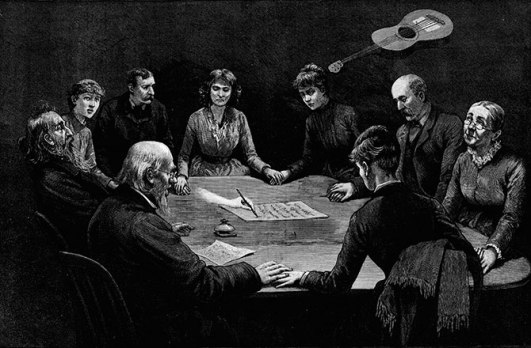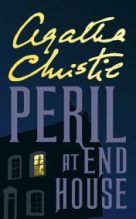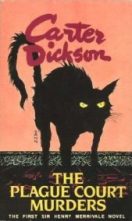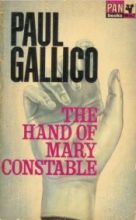
Flying lute? Check. Ghostly disembodied hand? Check. Okay, ladies and gentlemen, let’s call this meeting to order…

Flying lute? Check. Ghostly disembodied hand? Check. Okay, ladies and gentlemen, let’s call this meeting to order…
 Peril at End House (1932) by Agatha Christie I know, right? You’re thinking Well, I would have gone for The Sittaford Mystery, and you’re welcome to do so in your own list. This is only a brief scene towards the end, but I love the way Poirot just casually mentions Hastings’ (fictional) mediumistic abilities without first telling Hastings he’ll be doing so. We don’t learn much about the tricks, but I think this was the first séance I encountered in fiction, and the way Hastings has to ham it up without having any idea what’s coming really stuck with me. [Available from Harper Collins in print and ebook]
Peril at End House (1932) by Agatha Christie I know, right? You’re thinking Well, I would have gone for The Sittaford Mystery, and you’re welcome to do so in your own list. This is only a brief scene towards the end, but I love the way Poirot just casually mentions Hastings’ (fictional) mediumistic abilities without first telling Hastings he’ll be doing so. We don’t learn much about the tricks, but I think this was the first séance I encountered in fiction, and the way Hastings has to ham it up without having any idea what’s coming really stuck with me. [Available from Harper Collins in print and ebook] The Plague Court Murders (1934) by Carter Dickson Carr didn’t write much by way of séances, at least not as far as I’ve encountered, which given his love of the supernatural seems odd. And technically the expected setup — of people sitting around holding hands while a spirit raps and giggles — is really just the backdrop to the ‘real’ séance which sees a man stabbed in the back in a hut locked inside and out and surrounded by mud that snows not one single footprint. But there’s a great line on Who Was Where When at the point of detection, which exploits the factitious aspect of these undertakings beautifully. [Currently OOP — I know, I know, don’t get me started…]
The Plague Court Murders (1934) by Carter Dickson Carr didn’t write much by way of séances, at least not as far as I’ve encountered, which given his love of the supernatural seems odd. And technically the expected setup — of people sitting around holding hands while a spirit raps and giggles — is really just the backdrop to the ‘real’ séance which sees a man stabbed in the back in a hut locked inside and out and surrounded by mud that snows not one single footprint. But there’s a great line on Who Was Where When at the point of detection, which exploits the factitious aspect of these undertakings beautifully. [Currently OOP — I know, I know, don’t get me started…] The Hand of Mary Constable (1964) by Paul Gallico I’m not a fan of Gallico’s writing, nor of his hero Alexander Hero who seems to encounter all women first and foremost in terms of their attractiveness (even a twelve-year-old girl will, we’re told, grown up to be a real beauty…thanks, Paul). But this and its prequel Too Many Ghosts have some great ghostly manifestations, this getting the edge for the ‘unfakeable’ impression of a hand left in wax during a séance and the fact that there’s a combined set of explanations for virtually every ghostly manifestation going in these two books alone. Gallico also wrote The Poseidon Adventure, if you’re curious, and has one of the oddest bibliographies going for the sheer number of genres he hopped around in. [Currently OOP]
The Hand of Mary Constable (1964) by Paul Gallico I’m not a fan of Gallico’s writing, nor of his hero Alexander Hero who seems to encounter all women first and foremost in terms of their attractiveness (even a twelve-year-old girl will, we’re told, grown up to be a real beauty…thanks, Paul). But this and its prequel Too Many Ghosts have some great ghostly manifestations, this getting the edge for the ‘unfakeable’ impression of a hand left in wax during a séance and the fact that there’s a combined set of explanations for virtually every ghostly manifestation going in these two books alone. Gallico also wrote The Poseidon Adventure, if you’re curious, and has one of the oddest bibliographies going for the sheer number of genres he hopped around in. [Currently OOP] Rim of the Pit (1944) by Hake Talbot This is the positive ne plus ultra of fictional séances, with manifestations, a glowing disembodied face that floats away from our party and — when disbelieved and pursued through the house — disappears in front of several witnesses. But the part that really abides in my mind is the way Rogan Kincaid’s message to his grandmother is read despite being sealed in an envelope that remains unopened by the psychic leading the show. It’s just a nifty little trick, handily exposed as one by Kincaid’s own particular twist on the occasion… [Available from Ramble House in print and, possibly, ebook]
Rim of the Pit (1944) by Hake Talbot This is the positive ne plus ultra of fictional séances, with manifestations, a glowing disembodied face that floats away from our party and — when disbelieved and pursued through the house — disappears in front of several witnesses. But the part that really abides in my mind is the way Rogan Kincaid’s message to his grandmother is read despite being sealed in an envelope that remains unopened by the psychic leading the show. It’s just a nifty little trick, handily exposed as one by Kincaid’s own particular twist on the occasion… [Available from Ramble House in print and, possibly, ebook] To Say Nothing of the Dog (1997) by Connie Willis I’m out of era here, and it’s not even an impossible crime, but Willis’ time-travelling detective mystery is one of the most gloriously brilliant books I’ve read in the last ten years. With the fraud medium (yes, that’s a tautology) having her séance hijacked for reasons too complex to go into here, this becomes increasingly hilarious as we’re treated to her panic at having apparently actually contacted a spirit while the workings and counter-workings of the séance and the sabotage are gleefully detailed and spiral into ever-more ridiculous heights. [Available from Gollancz in print and ebook]
To Say Nothing of the Dog (1997) by Connie Willis I’m out of era here, and it’s not even an impossible crime, but Willis’ time-travelling detective mystery is one of the most gloriously brilliant books I’ve read in the last ten years. With the fraud medium (yes, that’s a tautology) having her séance hijacked for reasons too complex to go into here, this becomes increasingly hilarious as we’re treated to her panic at having apparently actually contacted a spirit while the workings and counter-workings of the séance and the sabotage are gleefully detailed and spiral into ever-more ridiculous heights. [Available from Gollancz in print and ebook]
I’d add in Peter Lovesey’s A Case Of Spirits, giving life to the Victorian obsession for such things. And there was that Death In Paradise episode, which might count…
There’s another one that’s scratching at the back of my head, an impossible crime where they’re all holding hands – it might be a short story though and I just can’t place it at the moment…
LikeLike
“There’s another one that’s scratching at the back of my head, an impossible crime where they’re all holding hands…”
You may be referring to episode 4.1 (Stab in the Dark) of Death In Paradise.
LikeLike
Um, no, that’s the Death In Paradise episode that I referred to in the first paragraph.
LikeLike
Then it might be Murder On Waverly Place by Victoria Thompson.
LikeLike
Could be. Looks like someone searched the word seance on my blog.
There’s also a short story (Medium Rare) by Bill Pronzini and, as I said in Murder On Waverly Place, I’m sure there’s a Carr short story or radio play with the everyone’s-holding-hands impossibility.
LikeLike
“Looks like someone searched the word seance on my blog.”
Well, I didn’t ! 🙂
LikeLike
In that case, respect for the recall of Murder on Waverly Place. Impressive.
LikeLike
Haven’t we established over the years that Santosh just knows everything? We’ll catch him out one day, for sure, but for the time being he’s some amalgam of The Wizard of Oz, Derren Brown, Richard Osman, and a Russian hacker with enough time on their hands to also read a bloody ton of books 😀
LikeLiked by 3 people
The Carr radio play is The Black Minute (1941). It is a brilliant story, one of Carr’s best. The script is available in 2 collections: The Dead Sleep Lightly and Fell And Foul Play.
LikeLiked by 1 person
I think that’s the one that I’m thinking of. Now I just have to work out where I read it…
LikeLike
TomCat has spoken highly of the Carr story in his review at http://moonlight-detective.blogspot.nl/2011/05/sound-of-detection.html
LikeLiked by 1 person
The Black Minute was also published in Ellery Queen’s Mystery Magazine (May 1983 issue)
LikeLike
And Daniel Stashower’s The Houdini Spectre, now I think of it. I did think of the DiP, actually, but figured I should resrict myself to novels for this first go-around, otherwise we’d be waiting months for this…!
LikeLike
My late compatriot, A.C. Baantjer, who was my formal introduction to the genre, wrote a great séance mystery: De Cock en de moord in séance, which was translated as DeKok and Murder in Seance. So, if you like these kind stories, you should definitely add that one to your list. John (from Pretty Sinister Books) has a good review, from 2011, on his blog.
You could also add John Sladek’s Black Aura to the list, which takes place in the home of a medium and Thackery Phin gives, sort of, a lecture about fake spiritualism.
Robin Forsythe’s The Spirit Murder Mystery is set in a house haunted by ghostly music and opens with an experimental séance.
Anita Blackmon’s There is No Return involves animal killings, the dead taking possession of the living and a gruesome throat-cutting during a séance in a darkened room. Recently, I reviewed Six Were Present by E.R. Punshon, which has an impossible stabbing in a locked and watched tower room during a séance.
Anthony Abbott’s The Murder of a Startled Lady has an interesting take on this: a spiritual medium claims to be contact with the ghost of a murdered woman, whose body has never been found, but the suspected con-artist actually manages to lead the police to the watery grave of the woman.
I can name a few more, but I guess this is enough to make you return to this subject sooner than planned. You’re welcome. 🙂
LikeLike
Hooray, new things! Ill be honest, I’ve struggled through (and with) a couple of Punshons and don’t find him quite the joy that a lot of other people currently are; perhaps an impossible crime would give me something to focus on… There’s every chance I skipped your review precisely because of my previous experience with him, so thanks for bringing this up!
LikeLike
Y-you don’t like Punshon? By Poe, you truly are a bowl of cold porridge!
LikeLike
I’ve just…not encountered him at his best, perhaps — I find him a bit leaden, but then it could just be the particular style of mystery I was reading from him. Hey, I’m willing to give SWP a go, so I can’t dislike him that much… 🙂
LikeLike
There was an interesting impossible crime short story in the manga/anime Tantei Gakuen Q/Detective Academy Q, where the participants in a séance were standing in a circle around the medium, all holding hands (with some of the detective protagonists in the circle too), and where the medium was stabbed in her back during a blackout.
Last year’s 3DS game Phoenix Wright Ace Attorney: Spirit of Justice had a great gimmick: spirit channeling is real (but rare) in that world, and through Divination Séances, a medium can project the last few minutes of the spirit’s life as seen through the eyes of the deceased upon a water mirror for everyone to see. It makes for some great mystery puzzle fiction, as you’re playing a defense attorney and at first sight, these Divination Séances only seem to prove that your client is indeed the murderer.
LikeLike
As if it;s not enough trying to accept the amount of superb Japanese detective novels I’ll likely never get a chance to read, this proliferation of manga and video games doing the same thing to a great standard really does seem to just be rubbing it in… 🙂
LikeLike
I’ve good news for you, JJ. The séance case from TGQ/DAQ was adapted for the anime series, covering episodes 12, 13 and 14, which can be found online with subtitles. So you should be able to enjoy that one.
LikeLiked by 1 person
The Ace Attorney is in English. 😉 While it doesn’t fit the criteria exactly, the second case of the second game has a locked room murder during an attempted channeling. But I found the mystery somewhat weak, but it sold me on mysteries. Hopefully I’ll get to writing about it.
And you could probably find TGQ in manga form on scantilation sites.
LikeLiked by 1 person
But don’t I need, like, a console or, er, someting to play it? And I don’t own a television. So, frankly, it can be in any language it likes, still can’t access it… 😀
LikeLike
They’re all on the DS or 3DS. But you can just use YouTube. 😛
LikeLike
That’s just…watching someone playing a video game, though, righr? I mean, that doesn’t sound fun at all…
LikeLike
From what I understand of the rules of Bev’s challenge, aside from obviously meeting the date of publication limit and the book being a mystery, you just have to have read it in the challenge year. So I’d say you can cover two categories in a post, as long as each category is covered by a separate book as you have done.
LikeLiked by 1 person
Perfect; that’s what I assumed, but as ever it’s always worth cheking in case I’ve grabbed the middle of the stick…
LikeLike
Dumb Witness. Not the best Christie by half, but the seance actually contains a key clue, and it’s the only example in my memory where nobody is trying to con anybody. Radio shows are full of examples. I think there’s a Sherlock Holmes episode or an Ellery Queen.
LikeLike
Dumb Witness may have been the first Christie where I actually strung together the clues into a more-or-less (probably less) correct pattern; don’t remember a séance, though — shall attempt to remember this for when I come around to reading it again.
LikeLike
I was trying to remember precisely which Sayers novel has Miss Climpson demonstrating her talents as a fraudulent medium — a pleonasm, I agree with both you and Charlie Brooker, for which reference thanks. I finally recalled it to be “Strong Poison”. The other interesting mystery seance that came to mind is the extended sequence in an old Charlie Chan movie, “Meeting at Midnight” (aka “Black Magic”), in which there’s a shooting but the bullet vanishes.
LikeLike
I need to read some of the Charlie Chan books, I’ve not yet got to Biggers and his stuff. *sigh* Well, let’s put him on the list…
And if anyone out there thinks “Oooo, vanishing bullets sound like my kinda thing,” well, there are not one — oh, no — but two in Ye Olde Book of Locked Room Conundrums: details here — enjoy!
LikeLike
Hm. Brooker’s a bit milder on the subject than some of us . . .
LikeLike
Ha, well, it’s not like he stopped there: here’s a second go-around — always remembering that he’ll have to temper his bile a bit if we wants to get published in a maintstream broadsheet newspaper, even if the notion of a press exhibiting restraint or concern for people’s feelings does currently seem like something beyond ridicule for the peolpe of this country at present… But this isn’t a blog about that, so I’ll learn from Brad’s experience and stop here 😀
LikeLike
“Brad’s experience”?
LikeLike
I don’t know if JJ means me, and I think I’ve lost the thread here because I don’t know who Brooker is. But I’m guessing that if JJ DOES mean me, it has to do with my constant attempts to like Halter. Time to give up and move on. Is THAT what you meant, JJ?
LikeLike
No, I’m referring to you “going political” and getting called up on it…
LikeLiked by 1 person
Again, late. Although not strictly a mystery movie, Fritz Lang’s Ministry of Fear has a nice eerie seance.
LikeLiked by 1 person